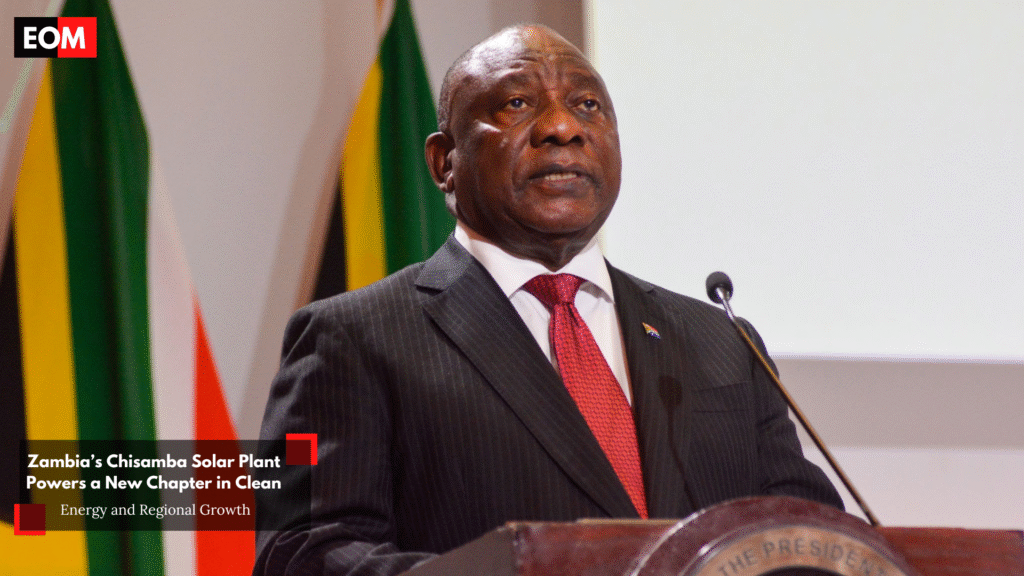Zambia’s Chisamba Solar Plant Powers a New Chapter in Clean Energy and Regional Growth

Chisamba, Zambia – Zambia has marked a major milestone in its journey toward energy security and sustainability with the commissioning of the 100 MW Chisamba Solar Power Plant, now the nation’s largest grid-connected solar facility. Officially inaugurated by President Hakainde Hichilema in June, the plant is a beacon of the country’s determination to diversify its energy mix, reduce climate vulnerability, and uplift communities through clean infrastructure.
From Hydropower Reliance to Renewable Resilience
For decades, Zambia’s power supply leaned heavily on hydropower assets like Kariba Dam and Kafue Gorge, but prolonged droughts in 2015 and 2019 exposed the risks of single-source dependency. Load-shedding reached up to 15 hours per day, disrupting mining, manufacturing, education, and daily life.
The Chisamba project represents a strategic pivot. Located in Central Province, the site was selected for its optimal solar exposure and proximity to transmission lines, making it ideal for large-scale solar integration. The plant helps buffer Zambia’s economy from hydrological volatility and enhances power availability for key sectors, particularly mining, agriculture, and industrial production.
A Foundation Built on Policy Reform and Investor Confidence
The project’s success is grounded in Zambia’s forward-thinking policy reforms, including the Renewable Energy Feed-in Tariff (REFiT) Policy, tax incentives, and simplified licensing procedures that made the country more attractive to international investors. These frameworks align with Zambia’s Vision 2030 and the African Union’s Agenda 2063, both of which emphasize sustainable energy access and economic inclusivity.
A US $100 million blended financing package led by Stanbic Bank Zambia, alongside seed equity from ZESCO and Kariba North Bank Extension Power Corporation, made the project financially viable. Risk mitigation was supported by regional development institutions, helping demonstrate that large-scale renewables are not only possible in sub-Saharan Africa but also bankable.
Cutting-Edge Technology and Engineering
Spanning over 250 hectares, Chisamba Solar features 250,000+ photovoltaic panels with anti-soiling coatings and single-axis trackers that boost energy yield by up to 18%. Power is stepped up via a 33/132 kV substation and fed directly into the national grid. A SCADA control system allows real-time monitoring, predictive maintenance, and performance optimization.
Future upgrades will include Battery Energy Storage Systems (BESS) to store excess daytime generation and release it during peak evening demand, strengthening grid stability.
Community Development and Job Creation
The project generated 1,300+ jobs during construction, with 98% filled by local workers. Training programs in PV installation, electrical safety, and grid systems have created a pipeline of skilled labor for Zambia’s growing clean energy sector.
Chisamba’s impact extends beyond energy: boreholes now provide clean water to nearby villages, and temporary construction housing is being converted into a technical training center and community health clinic. Partnerships with local schools are introducing STEM-based energy education, preparing the next generation of Zambian innovators.
Regional Integration and Export Potential
Through the Southern African Power Pool (SAPP), Zambia can now export surplus electricity to neighbors like Malawi and Zimbabwe, strengthening regional energy security. Chisamba’s success positions Zambia as a future leader in a Southern African Green Energy Corridor, where solar and hydropower are shared across borders to meet growing demand.
Driving Green Industry and Economic Expansion
Reliable power is crucial for Zambia’s mining sector, which accounts for over 70% of export earnings. Chisamba reduces reliance on diesel generators, enabling consistent production and supporting the marketing of Zambia’s copper as “green copper”—a valuable edge in low-carbon global supply chains.
Beyond mining, access to stable electricity is fueling agro-processing, SMEs, digital services, and manufacturing, with cold storage, IT outsourcing, and fabrication operations gaining momentum. These ripple effects are contributing to broader economic development and improved livelihoods.
Innovation Hub for Future Projects
Chisamba is also serving as a testbed for emerging technologies. Pilot programs with bifacial solar panels and AI-powered maintenance systems are being evaluated for scalability. Feasibility studies are underway for green hydrogen production, powered by surplus solar output, with future phases exploring hybrid solar-wind systems and large-scale storage.
A Model for Africa’s Renewable Transformation
Chisamba has already drawn interest from neighboring countries. Delegations from Botswana, Kenya, and Malawi have visited the facility to study Zambia’s public-private partnership model, community engagement framework, and regulatory ecosystem. Development finance institutions cite the project as proof that transparent policy, stakeholder alignment, and investor-friendly reforms can unlock Africa’s renewable potential.
A Symbol of Resilience and Hope
The Chisamba Solar Power Plant is more than an energy project—it’s a symbol of Zambia’s commitment to sustainability, innovation, and inclusive development. It offers a compelling blueprint for other nations across Africa seeking to leap forward in clean energy while empowering their citizens and economies.
As Zambia continues to invest in renewable solutions, Chisamba lights the way—generating not just electricity, but optimism for a greener, more prosperous future.

